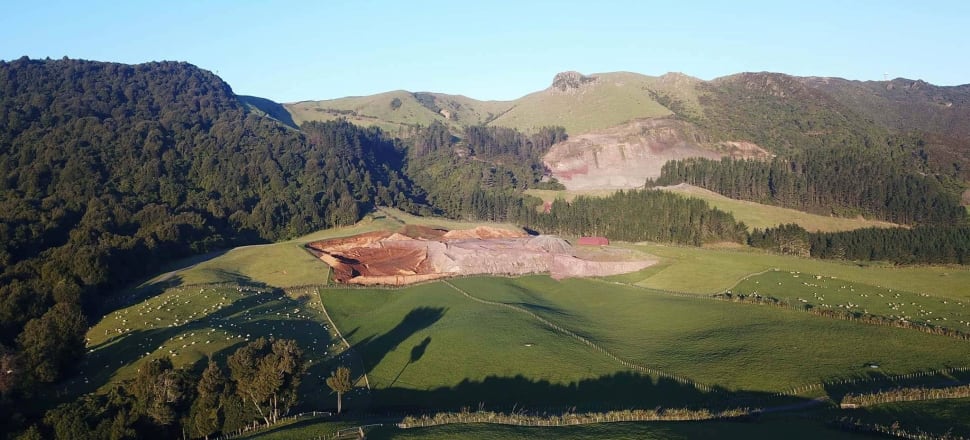
The quarry at Te Weraiti has disfigured an ancestral mountain and been detrimental to natural features of high significance
Opinion: Te Weraiti sits in the Kaimai Ranges above Matamata township. It’s the ancestral sacred mountain of Ngāti Hinerangi hapū o Raukawa iwi (ngā hapū). For more than 60 years, Te Weraiti has been quarried by a local company, Matamata Metal Supplies Ltd, in the face of objections from ngā hapū.
Matamata Metal Supplies is owned by J Swap Contractors, the same company that hit headlines in 2022 when Heritage New Zealand launched a rare prosecution against it over alleged partial destruction of a pā site near Tokoroa.
READ MORE:
* Ruapehu administrators deny iwi relations blame
* The need to accept that indigeneity matters
* Firefighting chemicals compromise Treaty settlement
The operation and expansion of the quarry at Te Weraiti has not only disfigured an ancestor, but also detrimentally affected natural features of high significance. Ngā hapū have long objected to the quarry discharging sediment into local rivers, rendering customary uses associated with these rivers obsolete.
Our research on the quarry’s effects has been incorporated into a recently filed Waitangi Tribunal claim, which alleges numerous Tiriti o Waitangi breaches in resource management decision making, quarrying activity on conservation land, breaches of consent conditions that were not investigated, and, in one instance, a complete absence of required resource consent.
Resource management breaches
The Tribunal claim identifies numerous alleged breaches of the important Tiriti principles of tino rangatiratanga, active protection, and partnership, among others. These relate to decisions made by the Crown and local government regarding Te Weraiti, particularly the failure of local councils to protect the mountain, despite petitions being brought to their attention in 1994 and again in 2012 seeking to recognise its spiritual importance.
Matamata-Piako District Council has a district plan that recognises wāhi tapu sites and internal council policy states the council is to be “responsive to” Māori heritage and culture. However, we believe the council ignored information about the importance of Te Weraiti, relying on the position that this information was provided outside of a plan change process.
The alleged Treaty breaches are intertwined with failures of Resource Management Act implementation, particularly failures of monitoring and enforcement.
Though Waikato Regional Council was acutely aware of hapū concerns about sediment discharge, several of the quarry’s resource consent conditions in relation to contaminant discharges were not adequately monitored.
This included water samples not being taken, monitoring results not being provided to Waikato Regional Council, discharges breaching consent conditions, and the discovery the quarry was using an aluminium-based flocculant (an agent used to combine smaller particles) that was being discharged into rivers.
A Waikato Regional Council site audit assessed there were areas of “significant non-compliance” – the worst grading criterion – yet the council refused to require a review of the consent conditions.
Other resource management failings relate to the consenting of activities. Some time before 2017, ngā hapū discovered evidence of quarry overburden deposited in an area not covered by the existing consent.
The land on which the overburden was deposited was conservation land, held by the Department of Conservation for the purpose of facilitating walking access to the Kaimai Ranges. The dumping of overburden had effects on this land, including on biodiversity and conservation values and on public access. However, DoC granted a retrospective concession for the activity, which did not require consultation with local hapū or the wider public.
Matamata-Piako District Council has acknowledged the overburden site was established without appropriate resource consent and yet decided not to take any enforcement action against the quarry.
A litany of failures
The decline in water quality from quarry discharges means ngā hapū are unable to practise their tikanga. In particular, they can no longer use their local rivers to remove and eliminate the state of tapu (sacredness) to noa (a state of safeness or normality). As stated in the claim, “how can we explain that we are using this clean, clear water for its cleansing and healing purposes, when it is filled with substances that have no place in healing and cleansing?”
The gradual loss of these traditional processes removes the connection between ngā hapū and their whenua (land) and awa (waters). With the degradation of the taiao (environment), ngā hapū are left to watch their tikanga being eroded, just as their ancestral mountain Te Weraiti suffers the same fate.
The new resource management system created by the Natural and Built Environment Act seeks to give effect to the principles of Te Tiriti o Waitangi and provide greater recognition of te ao Māori. But without an effective mechanism that transfers knowledge of te Tiriti and te ao Māori from the legislative level to a grassroots (local government) level, we risk continuing to produce legally incorrect decisions that negatively affect Māori and the taiao.
Elected decision makers at the council level cannot appropriately “give effect” to the principles of te Tiriti nor recognise te ao Māori if they do not have the requisite knowledge to engage in those decisions in the first instance.
Our research shows a clear failure in the relationship between the councils, DoC, and Matamata Metal Supplies to actively protect Māori interests in circumstances where many of their operating frameworks require them to do so. The case of Te Weraiti illustrates that:
* breaches of the law can go unnoticed even when consent conditions are sufficiently narrow to constrain the actions of the consent holder; * even if breaches of resource consents are identified, consent holders may face no punishments, and; * it is tangata whenua and the taiao that suffer as a result.
Taking action on these findings is essential to ensuring new legislation does not simply repeat past failures. Without appropriate mechanisms to ensure the enforcement of environmental laws and a mandatory requirement for education on te Tiriti and te ao Māori at the local government level, it seems likely Māori and the taiao will continue to finish as runners up.







